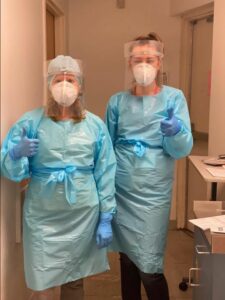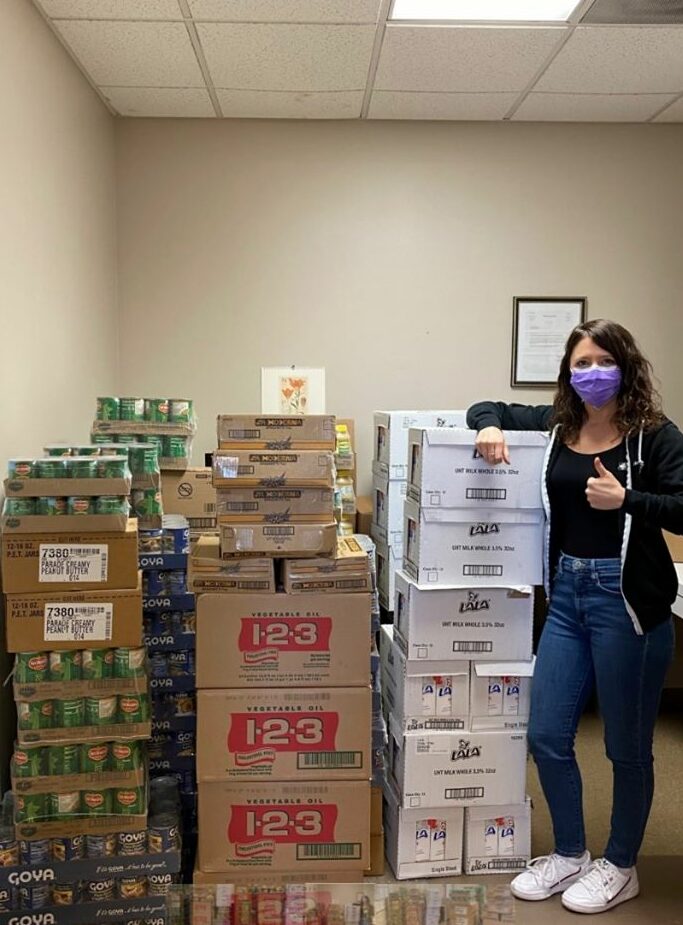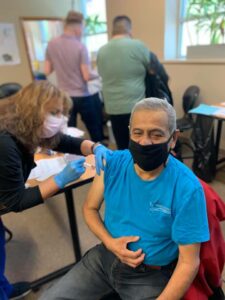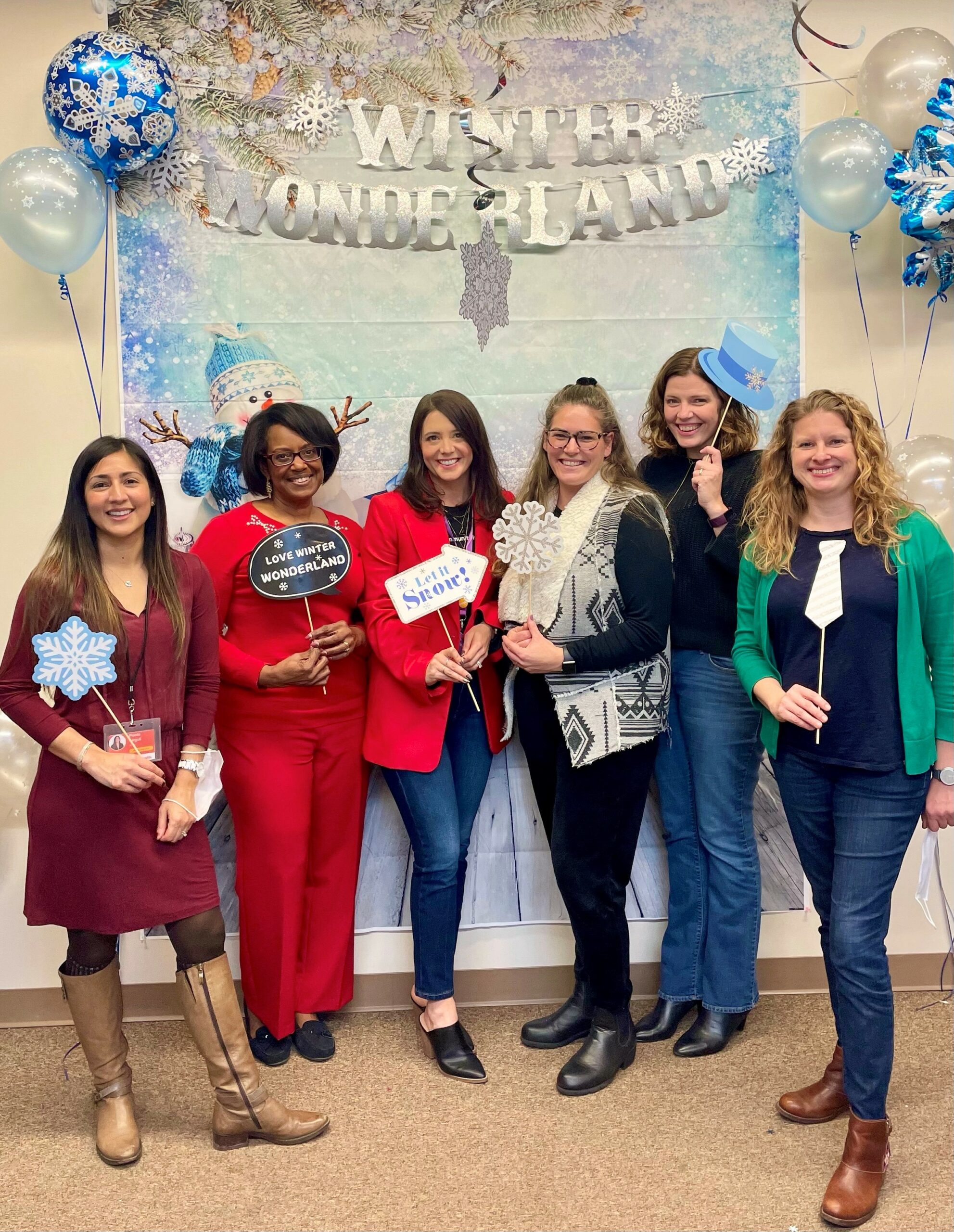My first day at CommunityHealth was November 11, 2019. It is hard to believe that it’s been two full years, and just as difficult to believe that it has only been two full years. After all, I started as the CEO just 121 days before the World Health Organization (WHO) declared COVID-19 a global pandemic.
I can still recall that time very clearly – we knew that COVID would come to the U.S., but the impact of what that meant was truly unknown. In fact, I was traveling on my honeymoon that first week of March. As my time away was winding down, I received a message from the clinic: we had a symptomatic patient onsite. Suddenly, this very distant virus was potentially hitting home (turns out, it wasn’t). I returned to the office with a weight on my shoulders and a knot in my stomach. It was the knowledge that, even if I didn’t know exactly how, everything was about to change. As I entered my office and sat in my chair, I turned around to see my white board. Before I left for my trip, I had written down three big, bold ideas I had, setting a vision for what I wanted to work with the team to implement. I sat there for longer than I probably should have and stared at the words that described what I hoped to build. Then I stood up, erased them, and called the Leadership Team into my office.
Everything had changed, and suddenly the only thing that mattered was keeping people safe.

Brave clinic staff, decked out in protective gear to administer COVID-19 tests.
Our mission in those first weeks was twofold: keep our patients out of over-crowded emergency departments and stay on top of the ever-changing protocols to keep everyone safe. That time was incredibly intense and, admittedly, terrifying.
If you can believe it, that very same whiteboard became our central command in the first weeks of the pandemic. It was the place where every change to clinic policy was detailed, and as guidelines changed, it was erased and rewritten. The clinic existed in a state of constant adaptation. The Leadership Team, now including our Volunteer Medical Director, met every morning to review protocols, change them as needed, and communicate to individuals who were both onsite and supporting our mission remotely.
Often by the afternoon, those recommendations would change, and the procedures we had just discussed that morning became immediately outdated.
From March to July of 2020, the non-patient facing staff worked from home, and on-site patient appointments were limited. Because of that, our once-bustling clinic felt eerily still, and there was a silent intensity as we all went about our work. Overnight, we pivoted the bulk of our appointments to telemedicine, while a small-but-mighty group of volunteers remained onsite for in-person appointments that were still needed for our patients to prevent unnecessary Emergency Room visits. Mary and Margaret – you two will forever be etched in my heart for being two of our steady hands in those early days.
The rest of the on-staff team included our incredible front desk, the dedicated pharmacy staff, our amazing Director of Operations, and the brave clinic coordinators, nurses, and medical assistants. And then there was me, working in my office, learning how to use Zoom. In between meetings, I would compile bags of food and personal hygiene items to give to our patients. I can still remember what the administrative office area felt like – it was quiet and smelled of soap and dried beans and spaghetti from the donations we were giving out to our patients. Our conference room became a self-care center, full of art supplies, a puppy livestream on the TV, and an affirmation wall that included positive sentiments to one another, art work we made, and jokes about carrying food boxes and storing up toilet paper.
I want to share one of my most vivid and cherished memories from those first few months. At the end of April, thanks to the combined strength of our partnerships with Northwestern Medicine, Rush University Medical Center, and the Chicago Department of Public Health, we were finally able to offer COVID testing to our patients. When I think back on that day, I can still feel the joy that was reverberating through our clinic. Our incredibly brave staff was beaming because they could now help our patients in a new way. If they had a second thought about their personal safety, you would have never known it. The word hero still does not have enough meaning for me in how I see our staff.

The administrative office was empty, except for me and a whole lot of food donations.
By early fall, we knew this pandemic was not a blip on the timeline – it would be with us for some time, and we were about to experience a second surge.
The thing about the pandemic is no one has escaped it. From lost jobs, to living alone feeling isolated, to losing loved ones to this virus – everyone suffered in some way during this time. The brave staff members and volunteers at CommunityHealth were no exception. They handled the pandemic for hours each day on-site, then went home to reckon with its effect on their families and communities. That winter we felt the devastation of the second surge. I have often described that time as being surrounded by constant illness and grief. Not only were our patients and their communities being disproportionately impacted by COVID (our positivity rate was consistently above 40%) but the families of our staff members were being deeply impacted as well. On occasion, we had to reduce hours or services simply because so many staff were out of the office from a high-risk exposure, from sickness, or they were on bereavement leave.
At CommunityHealth, our mission was built on the notion of hope and our ability to make lives better.
It is only fitting then that during our darkest moment, our greatest hope arrived: on December 29, 2020, we got our first COVID-19 vaccine jabs. If I thought that our first day of COVID testing was joyful, you should have seen the celebrations on display at the Malcolm X mass vaccination center. The staff working at that location came to know us as ‘the picture people’ because of the many, many celebratory photos we took together to acknowledge hope in the form of a shot. There were so many smiles and cheers and, for me, as I waited in the observation area watching the staff celebrate, some tears as well.

A patient receiving a COVID-19 dose at the Lederman Family Health Center.
With that jolt of hope and joy, we stepped into what would by our finest hour to date.
Now it was our turn to deliver hope to those who needed it most: our patients and community. The staff and volunteers were nearly a year into the pandemic, they were exhausted coming off the heels of the second surge, and there was an urgency unlike any we had felt before: vaccinate as many people as quickly as possible. At the time, I would tell the staff that we were in the final mile of an ultra-marathon, but we were just informed that we actually had another 26 miles to go and: we had to sprint them.
Once again, we found ourselves leading without a playbook. But in true CommunityHealth style, we wrote one as we lived it. We hosted the city of Chicago’s first community-based pop-up vaccine event in Belmont Cragin in February, and we continued to be a constant presence in that community through the spring. We also hosted vaccine clinics at our health center in West Town. I know the staff and volunteers were exhausted – beyond exhausted – during that time, but they continued with a common goal to protect our patients. I am not sure they will ever fully know just how much they inspired me and kept me going. And their hard paid off: we brought hope and protection to our patients. As of now, 74% of our patients are fully vaccinated and more than 15% are also boosted.

A patient receiving a dose at a vaccine pop-up event.
Our pandemic story is not only about COVID-19. At CommunityHealth, we chose to not just survive but to thrive.
Our goal was simple: the pandemic initiated major change whether we wanted it to or not, so we embraced a growth mindset and structured that into how we led the organization. In spring of 2021, we began to push ourselves to innovate in the midst of an unprecedented time. The health care industry at large was forced to make a rapid shift. Telehealth used to feel like a far-off dream, and overnight it became our new norm. When CommunityHealth began to offer telehealth appointments, we noticed that the no-show rate dropped from 19% to 13% within a few short weeks. We didn’t let this statistic just pass us by. We asked ourselves why; we turned inward with a critical eye, and we found opportunity during great challenge. The pandemic showed us that we could be patient centered in a way we had never been before – by meeting the patient where they are, rather than requiring them to come to us.
By late summer 2021, we had formed our philosophy of how we would emerge from the pandemic as an organization, stronger and more charged than ever in our mission to serve people without access to essential care. At CommunityHealth, we knew we had to rethink space and place for point of care to increase access in ways that promote hyperlocal access points in communities where our patients live and work. We will continue to build on the initiatives that work to achieve this but, for now, our focus is on opening micro access points in the community that utilize the power of telemedicine while also including the human-to-human experience of our model that inspires trust, builds bonds, and fosters wellness.
Our first telehealth microsite opened in Belmont Cragin, inside of Onward Neighborhood House, in April 2021, becoming the first site of its kind in the city of Chicago. At this location, patients receive an assisted virtual visit, which includes having a medical assistant take their vitals, draw their labs (if needed), and room them for a visit with their provider. This room is not a typical exam room, though. It is a telehealth room equipped with everything the patients need to conduct a video visit. Patients can also pick up their medications and receive direct referrals to our onsite partner – Onward House. Our initial outcomes from this site tell us that we are making a difference in the community, and we have begun to turn our attention to the growth of the microsite model.
CommunityHealth showed what we are truly made of during the pandemic, and we are only just getting started.
I cannot tell you exactly what happens next. We are entering our next phase of the pandemic, full of booster shots and new variants. What I do know is that CommunityHealth is stronger than ever before. Going into the pandemic, we had the firm foundation of more than 25 years serving our communities. Built by Dr. Serafino Garella, with the heartbeat of more than 1,000 volunteers, and the brain power and dedication of 45 staff members, we have always been a safe shelter for those who have no where else to go. But during the pandemic, we leveled up. We added new depth to our thought process, additional capabilities to our toolbox, and adopted new angles of approaching the problems that existed in the ‘beforetimes.’ Each of us individually and all of us collectively are changed forever. We move forward into the next unknown together, bonded through our shared experiences, our growth, and our consistent commitment to continue leveling up to do more and better for our patients.
On a final note, as the CEO, I am only as strong as my team. And our team is epic. Emily, Laura, Megan, Leisa, Ruth, Paola, and Babs: thank you.

The leadership team, gathered under one roof for the very first time at our holiday party earlier this month. (L to R: Paola Seguil, Leisa Mosley, Steph Willding, Megan Doerr, Laura Ciresi Starr, Emily Hendel)
